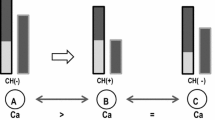Abstract
To further investigate the role of calcitonin (CT) in normal physiology we studied circulating forms and the secretion after “calcium clamp” in young and elderly healthy females. Heterogeneity of CT in serum was disclosed after immunoextraction, fast protein liquid chromatography, and radioimmunoassay in young (27±3 years; mean±SD, n=6) and elderly females (69±6 years, n=11). Three distinct molecular forms appeared with approximate mol wt of 30, 10, and 3–4 kDa. All young women studied had considerable amounts of circulating monomer-like CT whereas several elderly had undetectable or low levels. The influence of age on basal and calcium stimulated, immunoextracted CT in serum was also studied in young (26±4 years; mean±SD, n=13) and elderly (63±6 years; n=12) healthy females. The calcium stimulation was carried out by means of the standardized calcium clamp method, where calcium was kept on a presettled level at 1.45 mmol/liter (±2%) for 60 minutes. CT was immunoextracted from serum in all series of experiments with a polyclonal antiserum directed against the mid-and carboxyterminal region of the CT molecule, and the amount of extracted CT was determined by radioimmunoassay using another polyclonal antiserum against the carboxyterminal portion. After calcium infusion, the increase in CT was significantly higher in young women than in elderly (P<0.05). At basal conditions, the CT levels were not significantly different but slightly higher in young than in elderly females. In conclusion, several elderly women lack monomer-like calcitonin in serum in contrast to young women. After calcium stimulation of calcitonin, young women had higher serum concentrations than elderly women.
Similar content being viewed by others
References
Copp DH, Cameron EC, Cheney BA, Davidson AGF, Henze KG (1962) Evidence for calcitonin—a new hormone from the parathyroid that lowers blood calcium. Endocrinology 70:638–649
Hirsch PF, Voelkel EF, Munson PL (1963) Thyrocalcitonin: hypocalcemic hypophosphatemic principle of the thyroid gland. Science 146:412–413
Bucht E, Tørring O, Sjöberg HE (1985) Gel chromatography of immunoextracted plasma calcitonin in response to the calcium clamp in healthy males. Acta Endocrinol (Copenh) 110:421–428
Austin LA, Heath H III (1981) Calcitonin, physiology and pathophysiology. N Engl J Med 304:269–278
Deftos LJ, Weisman MH, Williams GW, Karpf DB, Frumar AM, Davidson BJ, Parthemore JG, Judd HL (1980) Influence of age and sex on plasma calcitonin in human beings. N Engl J Med 302:1351–1353
Reginster JY, Deroisy R, Albert A, Denis D, Lecart MP, Franchimont P (1989) Relationship between whole plasma calcitonin levels, calcitonin secretory capacity and plasma levels of estrone in healthy women and postmenopausal osteoporosis. J Clin Invest 3:1073–1077
Morimoto S, Onishi T, Okada Y, Tanaka K, Tsuji M, Kumahara Y (1979) Comparison of human calcitonin secretion after a 1-minute calcium infusion in young normal and in elderly subjects. Endocrinol Jpn 26:207–211
Body JJ, Heath H III (1983) Estimations of circulating monomeric calcitonin: physiological studies in normal and thyroidectomized man. J Clin Endocrinol Metab 57:897–903
Tørring O, Sjöberg HE (1983) A calcium clamp technique in man. Acta Physiol Scand 119:387–392
Tørring O, Bucht E, Sjöberg HE (1985) Plasma calcitonin response to a calcium clamp. Influence of sex and age. Horm Metab Res 17:536–539
Sjöberg HE, Tørring O, Granberg B, Ehrnsten U, Bucht E (1989) Postmenopausal osteoporosis: response of immunoextracted calcitonin to the calcium clamp. Bone 10:15–18
Chambers TJ, Moore A (1983) The sensitivity of isolated osteoclasts to morphological transformation by calcitonin. J Clin Endocrinol Metab 57:819–824
Bucht E, Telenius-Berg M, Lundell G, Sjöberg HE (1986) Immunoextracted calcitonin in milk and plasma from totally thyroidectomized women. Acta Endocrinol (Copenh) 103:572–576
Snedecor GW, Cochran WG (1980) Statistical methods (7th ed). Ames IA (ed) The Iowa State University Press, Iowa
Milhaud G, Benezech-Lefevre M, Moukthar MS (1978) Deficiency of calcitonin in age-related osteoporosis. Biomedicine 29:272–276
Taggart HM, Chesnut CH III, Ivey JL, Baylink DJ, Sisom K, Huber MB, Roos BA (1982) Deficient calcitonin response to calcium stimulation in postmenopausal osteoporosis? Lancet i:475–478
Prince RL, Dick IM, Prince RI (1989) Plasma calcitonin levels are not lower than normal in osteoporotic women. J Clin Endocrinol Metab 68:684–687
Tiegs RD, Body JJ, Heinz W, Wahner W, Barta J, Riggs BL, Health H III (1985) Calcitonin secretion in postmenopausal osteoporosis. N Engl J Med 312:1097–1100
Heath H III, Sizemore GW (1977) Plasma calcitonin in normal man. J Clin Invest 60:1135–1140
Hillyard CJ, Stevensohn JC, MacIntyre I (1978) Relative deficiency of plasma calcitonin in normal women. Lancet 1:952–961
Tørring O, Bucht E, Sjöberg HE (1987) Influence of sex steroid hormone levels on plasma calcitonin response to the “calcium clamp” in normal man. J Bone Miner Res 7:407–412
Goodman RH, Jacobs JW, Habener JF (1979) Cell-free translation of messenger RNA coding for a precursor of human calcitonin. Biochem Biophys Res Commun 91:932–938
Bucht E, Arver S, Sjöberg HE, Löw H (1983) Heterogeneity of immunoreactive calcitonin in human milk. Acta Endocrinol (Copenh) 103:572–576
Bucht E, Sjöberg HE (1987) Evidence for precursors of calcitonin/PDN-21 in human milk. Regul Pept 19:65–71
Tobler PH, Jöhl A, Born W, Maier R, Fischer J (1982) Identity of calcitonin extracted from normal human thyroid glands with synthetic human calcitonin (1-32). Biochem Biophys Acta 707:59–65
Lind L, Bucht E, Ljunghall S (1994) Pronounced elevation in circulating calcitonin in critical care patients is related to severity of illness and survival. Intensive Care Med 20
Assicot M, Gendrel D, Carsin H, Raymond J, Giulbaud J, Bouhon C (1993) High serum procalcitonin concentrations in patients with sepsis and infections. Lancet 341:515–518
Author information
Authors and Affiliations
Rights and permissions
About this article
Cite this article
Bucht, E., Rong, H., Sjöberg, H.E. et al. Serum calcitonin forms and concentrations in young and elderly healthy females. Calcif Tissue Int 56, 32–37 (1995). https://doi.org/10.1007/BF00298741
Received:
Accepted:
Issue Date:
DOI: https://doi.org/10.1007/BF00298741




